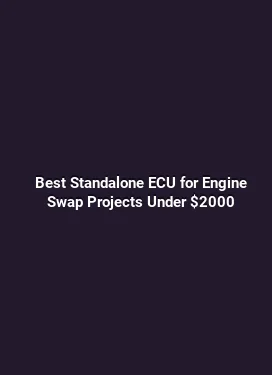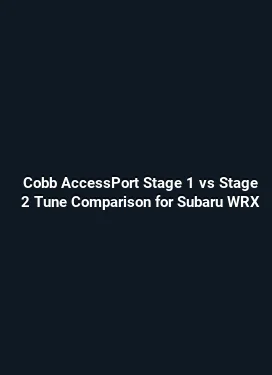E85 Ethanol Tuning Guide: AFR Targets and Ignition Timing for Power
Ethanol blends, particularly E85 (85% ethanol, 15% gasoline), offer significant performance potential when tuning is approached with a systematic, data-driven mindset. This guide delves into practical strategies for establishing target air-fuel ratios (AFR), selecting ignition timing maps, and applying real-world testing procedures to extract reliable power gains while maintaining driveability and safety. The discussion emphasizes a holistic approach that combines fuel delivery, ignition control, sensor feedback, and data logging to create a robust tuning methodology.
AFR Targets for E85: Balancing Power, Detonation Margin, and Emissions

When tuning for E85, the first consideration is establishing AFR targets that maximize power without compromising engine safety. E85’s high octane and cooling properties allow for more aggressive timing and higher cylinder pressures than typical gasoline blends, but this comes with unique fuel system requirements and combustion characteristics.
Base AFR targets begin with a stoichiometric reference and then shift toward a rich side as boost or load increases. A common starting point for naturally aspirated engines is a target in the mid-to-high 12:1 range under wide-open throttle (WOT). For boosted applications, richer targets in the 11:1 to 12:1 region are typical, depending on turbocharger or supercharger sizing, intercooling efficiency, and fuel delivery capability. The exact numbers hinge on several variables, including engine displacement, compression ratio, and the tune’s overall reliability window. The key is to secure sufficient rich mixtures to cool the intake charge and suppress knock while preserving enough energy density to sustain peak power.
Beyond a fixed AFR number, the approach should incorporate a map-based strategy that accommodates different operating envelopes. At low to mid load, slightly leaner trims can improve part-th throttle response and fuel economy, whereas WOT zones demand richer enrichment. A well-designed AFR map is shaped by repeated pulls, data from wideband sensors, and careful inspection of cylinder pressures and exhaust gas temperatures. In practice, this means establishing a baseline AFR curve that smoothly transitions across RPM and load, then validating it under realistic driving scenarios such as steady-state pulls, dynamic acceleration, and ambient temperature variations.
LSI-style considerations, such as sensor latency, fuel trim behavior, and ethanol content variability, should guide the refinement process. Flexible fuel sensing (FFS) or ethanol content measurement enables the ECU to adapt target AFRs automatically based on actual fuel composition. When such sensing is unavailable, manual compensation should be built into the map with conservative deltas to prevent lean spikes under transient conditions.
Ignition Timing Strategy for E85: Exploiting High Octane and Heat Absorption
Ignition timing is a critical lever when extracting power from E85. The high octane rating of ethanol reduces the propensity for knock, providing an opportunity to advance ignition timing compared to gasoline. However, the added cooling effect of ethanol and the different flame speed characteristics require careful calibration to avoid detonation caused by heat soak or rapid chamber pressure rises.
The general approach starts with conservative timing on the initial pull and progresses toward aggressive values as confidence grows in the tune’s stability. A practical method is to establish a timing base map with modest advance in low to mid RPM ranges, then progressively advance timing in higher RPM/boost regions where E85’s knock resistance supports it. During validation, monitor knock sensors, cylinder pressure indicators, and exhaust gas temperatures to ensure timing advancement does not introduce unwanted detonation under heavy load or high ambient temperatures.
One effective technique is to correlate ignition timing with AFR across the operating range. Because richer mixtures influence flame speed and combustion duration, the timing that works well at 12.0:1 can differ from the timing that works at 11.0:1. A robust map ties ignition timing to both RPM andLoad, with additional cells that adjust for ethanol content and cooling effectiveness from the intercooler. This approach helps maintain consistent flame propagation and avoids localized hotspots that could trigger knock or pre-ignition.
Beyond static timing, dynamic timing strategies, such as progressive advance with positive intake manifold temperature compensation, can help manage transients. During sudden throttle inputs, a staged timing approach—initial retardation during peak TPS transitions followed by gradual advancement as the engine stabilizes—can prevent misfires and preserve torque during meaningful load changes.
Practical testing sequence: validating AFR and timing adjustments

Begin with a controlled environment, using a chassis dyno or a road-based testing protocol that includes fixed-speed pulls and repeatable throttle application. Step through AFR targets in small increments (for example, 0.2 to 0.3 lambda steps, depending on the baseline). At each AFR, run multiple pulls under identical conditions to assess repeatability in power, torque, and fueling stability.
Record ignition timing across the map alongside AFR, AFR variance, and fuel pressure. Use data logs that capture wideband O2 output, MAP/MAF, ECT/CHT, and knock sensor activity. When the engine demonstrates stable torque gains and no audible or detected knock, you can consider refining the timing in the corresponding cells. The end goal is a cohesive AFR and timing interaction that delivers consistent power without excessive heat or instability.
Fuel System Considerations: Managing E85’s Demands
E85 has different energy density and chemical properties compared to gasoline, which translates to a need for robust fuel delivery and precise control. The higher latent heat of vaporization and oxygen content influence volumetric efficiency and injector duty cycle. A reliable tune depends on confirming that the fuel system can consistently meet the required flow and pressure targets across operating conditions.
Key steps include verifying injector sizing and ramp rates, ensuring sufficient pump capacity, and confirming that the fuel rail pressure remains within the ECU’s expected range under boost. If fuel pressure is not stable, the ECU can compensate with misleading trims that mask underlying issues, leading to run-to-run variation. In such cases, it is prudent to verify mechanical components before pushing the tune toward high-bleed AFR targets or aggressive timing changes.
Additionally, ethanol content variability plays a critical role. While some blends are advertised as E85, actual ethanol content can range, influencing stoichiometry and cooling. Implementing an ethanol content sensor or mapping a safety margin into the AFR targets can prevent lean excursions when the fuel mix is on the leaner side of the spectrum. In the absence of content sensing, conservative enrichment strategies and data-driven safeguards help maintain reliability across seasons and supply sources.
Injector dynamics and fueling strategies
With E85, injector flow must match the increased air mass at higher boost and RPM. It’s common to see higher duty cycles and potential spray pattern limitations at maximum fueling. To address this, tuning should consider injector latency, pulse width modulation accuracy, and the possibility of short pulse behavior at high fuel pressures. An effective approach is to characterize the injector’s actual flow at each duty cycle and temperature, then incorporate these findings into the fueling model. This ensures the ECU’s fuel trims align with real-world delivery rather than relying solely on theoretical tables.
In practice, establishing a conservative safety margin for fuel pressure and incorporating a bias in the fuel map that accounts for minor pressure drops helps to maintain stable AFR during aggressive acceleration or gear changes. A well-documented fueling strategy reduces the risk of transient lean spikes and helps the engine tolerate variations in intake air temperature or turbocharger performance.
Reliable tuning depends on expansive sensor coverage and robust data logging. Wideband O2 sensors provide real-time feedback on AFR and enable precise adjustments. Knock sensors, EGT sensors, and manifold pressure readings contribute to a safety net that identifies early signs of detonation or heat buildup. Logging should capture a dense set of variables, including RPM, load, throttle position, air mass flow, fuel pressure, and ambient conditions, to facilitate post-session analysis and reproducible results.
Trend analysis enables the tuner to identify subtle drifts in sensor readings that could signal issues like intercooler inefficiency, turbocharger bleed, or fuel delivery degradation. The use of trend lines and moving averages helps separate random noise from meaningful shifts in engine behavior. This data-centric approach makes it possible to optimize both peak power and mid-range torque while preserving engine longevity.
Practical logging discipline
Establish a baseline log for a stock-like scenario, then incrementally introduce E85 and boost while maintaining consistent environmental conditions. Compare successive runs to quantify the impact of each adjustment. When discrepancies appear, investigate sensor readings for anomalies such as intermittent wideband response or fluctuating fuel pressure. Documenting these observations creates a repeatable tuning workflow that can be shared across the tuning team or revisited after hardware changes.
Although the primary aim is power, a holistic tune considers long-term durability and controllable emissions. E85’s cleaner burning profile, when properly tuned, can reduce certain hydrocarbon emissions due to more complete combustion, yet high boost and aggressive timing can increase NOx formation if not managed correctly. A disciplined approach uses a balanced AFR map and a timing strategy that respects the engine’s cooling capacity and exhaust aftertreatment constraints.
Durability testing across multiple operating conditions—hot soak start, cold start, and sustained high-load operation—helps reveal whether the tune remains within safe limits across temperature gradients. The goal is a stable, repeatable performance envelope that remains within the engine’s mechanical and thermal boundaries while delivering the desired power uplift from E85 enrichment.
Heat management and cooling strategies
E85 can introduce additional heat into the combustion process due to richer mixtures and higher turbine/engine loads. Monitoring intake air temperatures, charge cooling efficiency, and cooling system capacity is essential. Upgrades to intercooling, radiator capacity, and oil cooling can complement the tuning work by preserving charge density and maintaining consistent ignition timing across dynamic operating conditions.
Engine management strategies should also account for ambient temperature and humidity. As temperatures rise, octane stability remains favorable, but detonation margins can erode if heat rejection is insufficient. Proactive measures, such as ensuring clean intercooler plumbing and verifying thermostat performance, contribute to a more stable tuning outcome when operating outside typical climate ranges.
For tuners seeking long-term performance, outlining a plan that includes potential hardware upgrades—such as higher flowing injectors, reinforced fuel pumps, or improved intercooling—helps align the tuning strategy with future goals. A forward-looking approach keeps the AFR and timing maps flexible enough to accommodate new hardware while maintaining safety margins. Documentation of the tuning rationale and testing results is valuable for future iterations and collaboration with other engineers or enthusiasts.
Additionally, embracing data-driven methods—like predictive trim models based on fuel composition and environmental variables—can offer a path to smoother driveability and more consistent performance across a wider operating range. As technology evolves, leveraging more advanced sensors and real-time analytics becomes a practical route to sustaining gains achieved through E85 tuning.
In summary, tuning E85 requires an integrated view of fuel delivery, ignition control, sensor feedback, and testing discipline. By establishing robust AFR targets, optimizing ignition timing with respect to ethanol’s properties, and validating these choices with thorough data logging, one can unlock meaningful power while preserving engine health and reliability. The practical steps outlined here are designed to be applied iteratively, enabling a tuning workflow that adapts to hardware, fuel quality, and climatic conditions without sacrificing the core objective: reliable, repeatable, and measurable performance improvements.






